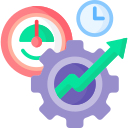Make Time Work for You with Automated Scheduling and Planning Tools
Chosen theme: Automated Scheduling and Planning Tools. Welcome to a space where calendars quiet down and priorities get loud. Expect practical playbooks, honest stories, and smart tactics that help automation clear roadblocks, not create them. Have a gnarly scheduling headache? Share it in the comments and subscribe for weekly, human-first insights.




Measuring Impact and ROI
Look beyond gut feel. Track time-to-assign, schedule stability, utilization balance, on-time delivery, and escalation rates. Teams often report fewer interruptions, quieter Slack channels, and calmer standups when automation consistently removes friction.
Measuring Impact and ROI
Before automation, a support team reassigned tickets three times on average. After intelligent routing and capacity awareness, reassignment dropped by two thirds, first-response time improved, and customers noticed. Engagement went up because agents finally owned outcomes.
Measuring Impact and ROI
Define baseline metrics, run a timeboxed pilot, compare throughput and predictability, and tally saved coordination hours. Invite frontline feedback weekly. If it feels easier and numbers agree, scale gradually and celebrate milestones to drive adoption.
Integrations That Make Automation Sing
Sync recurring events, PTO, client stages, and ticket priorities. When data flows both ways, schedules reflect reality, not hopes. Invite readers to share their most essential integration and why it keeps their team in rhythm.


Designing for Trust and Control
People accept suggestions when they see the logic. Show constraints, priorities, and trade-offs behind each assignment. A one-line explanation beside every automated action turns mystery into mentorship and builds lasting confidence.
Designing for Trust and Control
Offer quick overrides, drag-and-drop changes, and soft constraints that bend when context demands. The best systems make it easy to accept, tweak, or reject suggestions without punishment, then learn from those decisions over time.
Constraints and Optimization
Solvers juggle constraints—availability, skills, dependencies—seeking feasible, high-quality schedules. Techniques like constraint programming and heuristic search balance optimality with speed, surfacing plans that respect reality while nudging toward better outcomes.
Learning from Feedback
When humans adjust assignments, the system can learn preferences: who pairs well, which tasks need buffers, where context switching hurts. Over time, personalized schedules feel surprisingly human, because they are trained by humans.
Graceful Rescheduling
Life happens. Good tools minimize disruption by preserving commitments, reflowing work with minimal churn, and communicating changes clearly. Think surgical updates, not calendar earthquakes, so everyone stays focused and confident through change.
Implementation Playbook You Can Start Today
Pilot with Purpose
Pick a narrow, painful workflow—on-call rotations, client onboarding, or sprint planning. Define a clear success metric, timebox the experiment, and recruit champions. Invite readers to comment with their pilot idea for peer feedback.
Map Data and Policies
List sources of truth for capacity, priorities, and deadlines. Convert informal rules into explicit constraints. When policies become data, tools can actually help, and exceptions stop feeling like emergencies every other afternoon.
Metrics and Feedback Loops
Establish weekly reviews to inspect metrics, friction points, and surprising wins. Keep changes small, document decisions, and share highlights widely. Momentum compounds when people see progress and understand exactly why it’s working.


Edge Cases, Ethics, and Resilience
Avoid overloading your most capable people by codifying limits and rotating opportunities. Track distribution and alert on imbalances. Fair schedules protect wellbeing, reduce burnout, and create more sustainable performance across the team.
Edge Cases, Ethics, and Resilience
Schedule data can reveal sensitive patterns. Enforce least-privilege access, mask unnecessary details, and log who sees what. Communicate policies openly so teammates know exactly how their information is used and protected.
